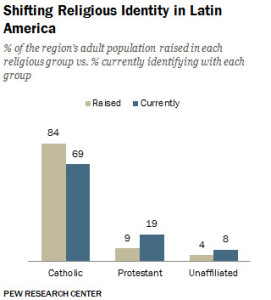 Last week the Pew Research Center released findings from their recent survey examining religious affiliations, beliefs and practices in 18 countries and one U.S. territory (Puerto Rico) across Latin America and the Caribbean. While this region of the world is home to over 400 million Catholics (nearly 40% of the global total) and despite the popularity of the first Latin American Pope, affiliation with Catholicism is declining rapidly.
Last week the Pew Research Center released findings from their recent survey examining religious affiliations, beliefs and practices in 18 countries and one U.S. territory (Puerto Rico) across Latin America and the Caribbean. While this region of the world is home to over 400 million Catholics (nearly 40% of the global total) and despite the popularity of the first Latin American Pope, affiliation with Catholicism is declining rapidly.
Dramatic Decline
From the 1900s through the 1960s survey data shows that over 90% of people living in this region were Catholic. Since that time, decline has become normative.
- 84% of the region’s current adults were raised Catholic, but only 69% continue to be affiliated with that tradition.
- 9% of the the region’s current adults were raised Protestant, but an incredible 19% now are affiliated with this tradition thanks primarily to religious switching from Catholicism.
So What?
In the course of a single generation, Latin American religion has shifted significantly. More than twice as many people are now Protestant compared to those raised in that tradition (19% vs. 9%), and a similar growth has occurred among those with no religious affiliation (8% vs. 4%). This growth is largely transfer growth as people have transitioned away from Catholicism.
Those who have left Catholicism for Protestantism have done so for many reasons. In order of frequency from greatest to least common those include
- seeking a personal connection with God
- enjoy different style of worship
- wanting greater emphasis on morality
- appreciate church that helps members more
- outreach (done by new/Protestant church)
- personal problems
- seeking better financial future
- marriage to a non-Catholic.
Behind these self-identified reasons for switching from Catholicism to Protestantism is an important religious reality: Protestants are sharing their faith at higher levels that Catholics while also actively inviting Catholics to join them for worship in their Protestant congregations.
The trends in American religious affiliation look quite different than those in Latin America. The only group showing sustained growth is the non-affiliated while mainline/oldline Protestants are the only group showing sustained decline. What lessons might American Protestants glean from the shifts in Latin American religious affiliation?